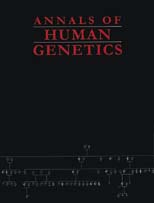Crossref Citations
This article has been cited by the following publications. This list is generated based on data provided by
Crossref.
Graham, Robert R.
Ortmann, Ward A.
Langefeld, Carl D.
Jawaheer, Damini
Selby, Scott A.
Rodine, Peter R.
Baechler, Emily C.
Rohlf, Kristine E.
Shark, Katherine B.
Espe, Karl J.
Green, Linda E.
Nair, Rajan P.
Stuart, Philip E.
Elder, James T.
King, Richard A.
Moser, Kathy L.
Gaffney, Patrick M.
Bugawan, Teodorica L.
Erlich, Henry A.
Rich, Stephen S.
Gregersen, Peter K.
and
Behrens, Timothy W.
2002.
Visualizing Human Leukocyte Antigen Class II Risk Haplotypes in Human Systemic Lupus Erythematosus.
The American Journal of Human Genetics,
Vol. 71,
Issue. 3,
p.
543.
Bouqbis, L.
Akhayat, O.
Garchon, H.‐J.
Calafell, F.
and
Izaabel, H.
2003.
TNFA–TNFB haplotypes modify susceptibility to type I diabetes mellitus independently of HLA class II in a Moroccan population.
Tissue Antigens,
Vol. 61,
Issue. 1,
p.
72.
Hirschhorn, Joel N.
2003.
Genetic epidemiology of type 1 diabetes.
Pediatric Diabetes,
Vol. 4,
Issue. 2,
p.
87.
Donn, Rachelle
Alourfi, Zaynab
Zeggini, Eleftheria
Lamb, Rebecca
Jury, Francine
Lunt, Mark
Meazza, Christina
De Benedetti, Fabrizio
Thomson, Wendy
and
Ray, David
2004.
A functional promoter haplotype of macrophage migration inhibitory factor is linked and associated with juvenile idiopathic arthritis.
Arthritis & Rheumatism,
Vol. 50,
Issue. 5,
p.
1604.
Kelly, M. Ann
Barnett, Anthony H.
and
Bain, Stephen C.
2004.
International Textbook of Diabetes Mellitus.
Spijker, G.T.
Nolte, I.M.
Jansen, R.C.
and
Te Meerman, G.J.
2005.
Genetic Association Studies in Complex Disease: Disentangling Additional Predisposing Loci from Associated Neutral Loci Using a Constrained ‐ Permutation Approach.
Annals of Human Genetics,
Vol. 69,
Issue. 1,
p.
90.
Serajee, Fatema J.
Zhong, Hailang
and
Mahbubul Huq, A.H.M.
2006.
Association of Reelin gene polymorphisms with autism.
Genomics,
Vol. 87,
Issue. 1,
p.
75.
Gauthier, J
Joober, R
Dubé, M-P
St-Onge, J
Bonnel, A
Gariépy, D
Laurent, S
Najafee, R
Lacasse, H
St-Charles, L
Fombonne, É
Mottron, L
and
Rouleau, G A
2006.
Autism spectrum disorders associated with X chromosome markers in French-Canadian males.
Molecular Psychiatry,
Vol. 11,
Issue. 2,
p.
206.
Stewart, D. R.
Dombroski, B. A.
Urbanek, M.
Ankener, W.
Ewens, K. G.
Wood, J. R.
Legro, R. S.
Strauss, J. F.
Dunaif, A.
and
Spielman, R. S.
2006.
Fine Mapping of Genetic Susceptibility to Polycystic Ovary Syndrome on Chromosome 19p13.2 and Tests for Regulatory Activity.
The Journal of Clinical Endocrinology & Metabolism,
Vol. 91,
Issue. 10,
p.
4112.
Thomson, Glenys
and
Valdes, Ana Maria
2007.
Conditional genotype analysis: detecting secondary disease loci in linkage disequilibrium with a primary disease locus.
BMC Proceedings,
Vol. 1,
Issue. S1,
Van Der Slik, A. R.
Van Den Eng, I.
Eerligh, P.
Doxiadis, I. I. N.
Koeleman, B. P. C.
Roep, B. O.
and
Giphart, M. J.
2007.
Sequence variation within the major histocompatibility complex subregion centromeric of HLA class II in type 1 diabetes.
Tissue Antigens,
Vol. 69,
Issue. 4,
p.
348.
Aminkeng, Folefac
Van Autreve, Jan E.
Koeleman, Bobby P.C.
Quartier, Erik
Van Schravendijk, Chris
Gorus, Frans K.
and
Van der Auwera, Bart J.R.
2007.
TNFa microsatellite polymorphism modulates the risk of type 1 diabetes in the Belgian population, independent of HLA-DQ.
Human Immunology,
Vol. 68,
Issue. 8,
p.
690.
Lie, Benedicte A.
Viken, Marte K.
Akselsen, Hanne E.
Flåm, Siri T.
Pociot, Flemming
Nerup, Jørn
Kockum, Ingrid
Cambon-Thomsen, Anne
Thorsby, Erik
and
Undlien, Dag E.
2007.
Association analysis in type 1 diabetes of the PRSS16 gene encoding a thymus-specific serine protease.
Human Immunology,
Vol. 68,
Issue. 7,
p.
592.
Sawcer, Stephen
2008.
The complex genetics of multiple sclerosis: pitfalls and prospects.
Brain,
Vol. 131,
Issue. 12,
p.
3118.
Alizadeh, Behrooz Z.
and
Koeleman, Bobby P.C.
2008.
Genetic polymorphisms in susceptibility to Type 1 Diabetes.
Clinica Chimica Acta,
Vol. 387,
Issue. 1-2,
p.
9.
Thomson, Glenys
Barcellos, Lisa F.
and
Valdes, Ana M.
2008.
Genetic Dissection of Complex Traits.
Vol. 60,
Issue. ,
p.
253.
Cheung, Yee Him
Watkinson, John
and
Anastassiou, Dimitris
2011.
Conditional meta-analysis stratifying on detailed HLA genotypes identifies a novel type 1 diabetes locus around TCF19 in the MHC.
Human Genetics,
Vol. 129,
Issue. 2,
p.
161.
Valdes, A. M.
Erlich, H. A.
Carlson, J.
Varney, M.
Moonsamy, P. V.
and
Noble, J. A.
2012.
Use of class I and class II HLA loci for predicting age at onset of type 1 diabetes in multiple populations.
Diabetologia,
Vol. 55,
Issue. 9,
p.
2394.
Kamalbeik, Sepideh
Talaie, Haleh
Mahdavinejad, Arezou
Karimi, Abdollah
and
Salimi, Alireza
2014.
Multidrug-resistantAcinetobacter baumanniiinfection in intensive care unit patients in a hospital with building construction: is there an association?.
Korean Journal of Anesthesiology,
Vol. 66,
Issue. 4,
p.
295.


